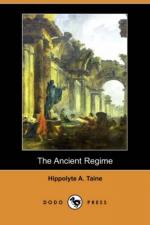letters, memoirs and detailed statistics preserved
in the one hundred boxes of the ecclesiastical committee,
the correspondence, in 94 bundles, of the department
and municipal authorities with the ministries from
1790 to 1799, the reports of the Councilors of State
on mission at the end of 1801, the reports of prefects
under the Consulate, the Empire, and the Restoration
down to 1823. There is such a quantity of unknown
and instructive documents besides these that the history
of the Revolution seems, indeed, to be still unwritten.
In any event, it is only such documents, which can
make all these people come alive. The lesser
nobles, the curates, the monks, the nuns of the provinces,
the aldermen and bourgeoisie of the towns, the attorneys
and syndics of the country villages, the laborers
and artisans, the officers and the soldiers.
These alone enable us to contemplate and appreciate
in detail the various conditions of their existence,
the interior of a parsonage, of a convent, of a town-council,
the wages of a workman, the produce of a farm, the
taxes levied on a peasant, the duties of a tax-collector,
the expenditure of a noble or prelate, the budget,
retinue and ceremonial of a court. Thanks to
such resources, we are able to give precise figures,
to know hour by hour the occupations of a day and,
better still, read off the bill of fare of a grand
dinner, and recompose all parts of a full-dress costume.
We have even, on the one hand, samples of the materials
of the dresses worn by Marie Antoinette, pinned on
paper and classified by dates. And on the other
hand, we can tell what clothes were worn by the peasant,
describe the bread he ate, specify the flour it was
made of, and state the cost of a pound of it in sous
and deniers.[2] With such resources one becomes almost
contemporary with the men whose history one writes
and, more than once, in the Archives, I have, while
tracing their old handwriting on the time-stained paper
before me, been tempted to speak aloud with them.
H. A. Taine, August 1875.
Notes:
[1]. Taine’s friend who was the director
of the French National Archives. (Sr.)
[2]. One sou equals 1/20th of a franc or 5 centimes.
12 diniers equaled one sou. (Sr.)
BOOK FIRST. THE STRUCTURE OF THE ANCIENT SOCIETY.
CHAPTER I. THE ORIGIN OF PRIVILEGES.
In 1789 three classes of persons, the Clergy, the
Nobles and the King, occupied the most prominent position
in the State with all the advantages pertaining thereto
namely, authority, property, honors, or, at the very
least, privileges, immunities, favors, pensions, preferences,
and the like. If they occupied this position
for so long a time, it is because for so long a time
they had deserved it. They had, in short, through
an immense and secular effort, constructed by degrees
the three principal foundations of modern society.




